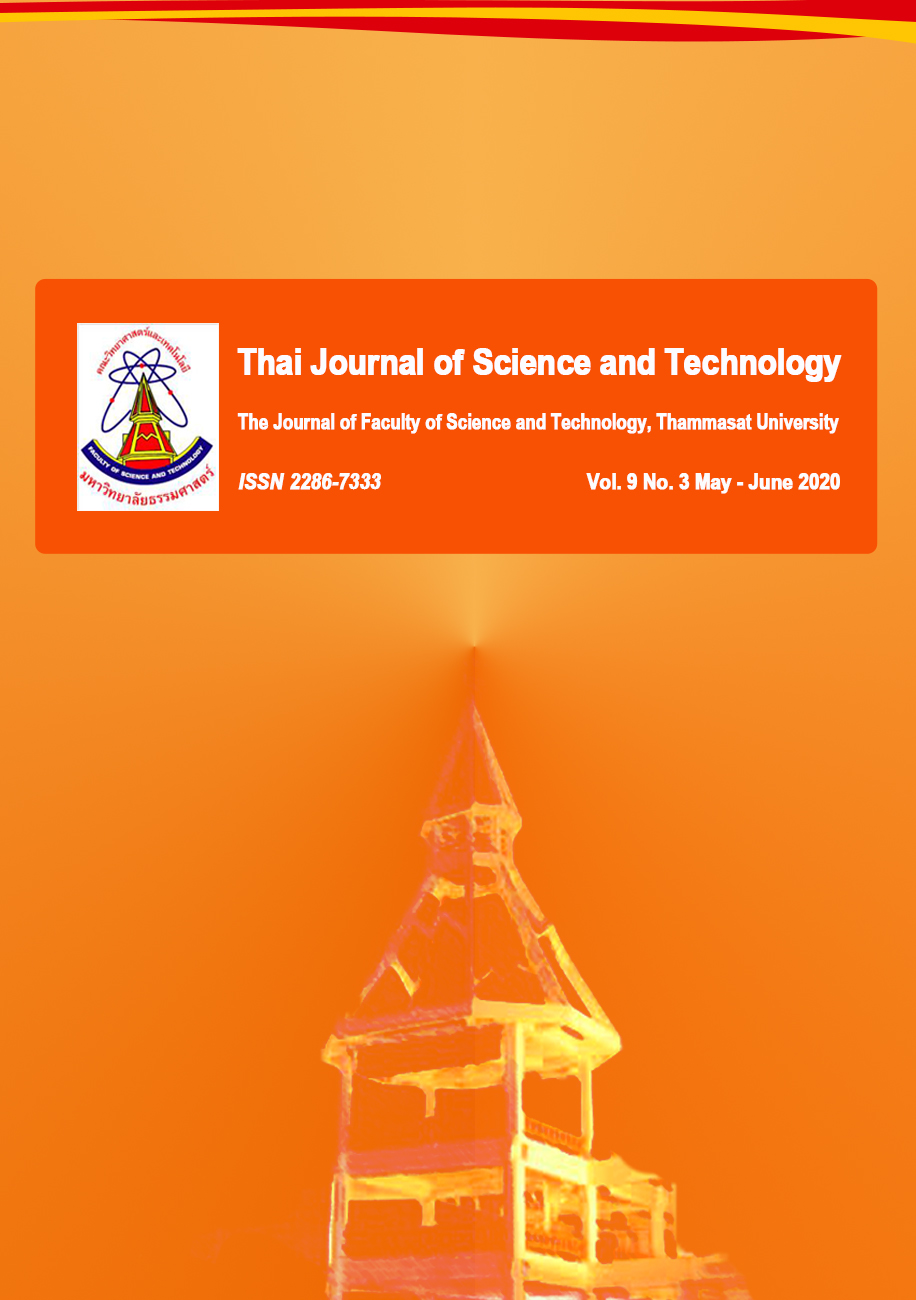Evaluation of the Carbon Footprint of Fresh Durian Grown in an Agroforestry System in Uttaradit Province, Thailand
Main Article Content
Abstract
The calculation of carbon footprint (CF) as an estimate of greenhouse gas emissions is one method used to measure environmental impact. Including carbon labeling on a product informs consumers of the environmental cost of that product during every stage of its life cycle (PLC), from acquisition and processing of raw materials to manufacturing, distribution and ultimate use. The purpose of this study was to estimate the CF of durian grown within an agroforestry system, including the removal of unconsumed portions of the fruit, in Ban Dan Na Kham, Uttaradit province, Thailand. Acquiring and processing fresh durian were responsible for 0.355 kg CO2-eq and 0.00018 kg CO2-eq, respectively. Distribution of fresh durian had a CF of 0.0359 kg CO2-eq, and consumption was considered to have a CF of zero. Disposal of the inedible parts of durian constituted the largest CF component (1.9006 kg CO2-eq), almost 83 % of the total CF (2.30 kg CO2-eq) for all processes. Reducing disposal of the inedible portion of durian by selling it pre-peeled for consumers or reusing the peel for a variety of packaging purposes may help to reduce the environmental impact of fresh durian production.
Article Details
บทความที่ได้รับการตีพิมพ์เป็นลิขสิทธิ์ของคณะวิทยาศาสตร์และเทคโนโลยี มหาวิทยาลัยธรรมศาสตร์ ข้อความที่ปรากฏในแต่ละเรื่องของวารสารเล่มนี้เป็นเพียงความเห็นส่วนตัวของผู้เขียน ไม่มีความเกี่ยวข้องกับคณะวิทยาศาสตร์และเทคโนโลยี หรือคณาจารย์ท่านอื่นในมหาวิทยาลัยธรรมศาสตร์ ผู้เขียนต้องยืนยันว่าความรับผิดชอบต่อทุกข้อความที่นำเสนอไว้ในบทความของตน หากมีข้อผิดพลาดหรือความไม่ถูกต้องใด ๆ
References
Fornara, D.A., Olave, R., Burgess, P., Delmer, A., Upson, M. and McAdam, J., 2018, Land use change and soil carbon pools: Evidence from a long-term silvopastoral experiment, Agrofor. Syst. 92: 1035-1046.
Greenhouse Gas Management Organization, Promotion of Carbon Footprint of the Product, Available Source: http://www.tgo.or.th/index.php?option=com_content&task=view&id=118&Itemid=2, January 10, 2015.
Gordon, A. and Thevathasan, N., 2006. How much Carbon can be stored in Canadian Agroecosystems Using a Silvopastoral Approach?, pp. 210-219, In Mosquera-Losada, M., McAdam, J., Rigueiro-Rodríguez, A. (Eds.), Silvopastoralism and Sustainable Land Management, CABI Publishing, Wallingford.
Haile, S.G., Nair, V.D. and Nair, P.K.R., 2010, Contribution of trees to carbon storage in soils of silvopastoral systems in Florida, USA, Glob. Change Biol. 16: 427-438.
Intergovernmental Panel on Climate Change, Climate Change, Working Group I: The Physical Science Basis, Available Source: http://ipcc.ch/publications_and_data/ar4/wg1/en/ch2s2-10-2.html, June 17, 2012.
IPCC, 2000, Land Use, Land-use Cchange, and Forestry: Summary for Policymakers, A Special Report of the Intergovernmental Panel on Climate Change, WMO (World Meteorological Organization), UNEP (United Nations Environment Programme), Geneva.
Jonathan, H., Cathy, H., Geoff, S., Alex, H., Stuart, W. and Pete, S., 2008. The carbon footprints of food crop production, Int. J. Agric. Sustain. 7: 107-118.
Mosquera-Losada, M.R., Freese, D. and Rigueiro-Rodríguez, A., 2011, Carbon Sequestration in European Agroforestry Systems, pp. 43-59, In Kumar, B.M. and Nair, P.K.R. (Eds.), Carbon Sequestration Potential of Agroforestry Systems: Opportunities and Challenges, Springer, Dordrecht.
Nair, P.K.R., Nair, V.D., Mohan Kumar, B. and Haile, S.G., 2009, Soil carbon sequestration in tropical agroforestry systems: A feasibility appraisal, Environ. Sci. Policy 12: 1099-1111.
Bunyaratpan, P., 2010, Thailand Greenhouse Gas Emissions, Available Source: http://www.pcd.go.th/info_serv/reg_std_water05.html, September 9, 2015.
Schroeder, P., 1994, Carbon storage benefits of agroforestry systems, Agrofor. Syst. 27: 89-97.
Takimoto, A., Nair, V.D. and Nair, P.K.R., 2009, Contribution of trees to soil carbon sequestration under agroforestry systems in the West African Sahel, Agrofor. Syst. 76: 11-25.
The Office of Agricultural Economics, 2015, 6th Study of Greenhouse Gas Emissions of Products Fresh Durian in the Green Agricultural Area Chantaburi Province, Office of Agricultural Economics, Ministry of Agriculture and Cooperatives, Bangkok. (in Thai)
Mungjaroen, T., 2007, Life Cycle Assessment (LCA): Tool for CDM, National Science and Technology Development Agency, Bangkok. (in Thai)
Udawatta, R.P. and Jose, S., 2011, Carbon Sequestration Potential of Agroforestry Practices in Temperate North America, pp. 17-42, In Kumar, B.M. and Nair, P.K.R. (Eds.), Carbon Sequestration Potential of Agroforestry Systems: Opportunities and Challenges, Springer, Dordrecht.
Wushuai, Z., Xiaoming, H., Zhongdong, Z., Shuai, G., Qiang, Z., Wei, Z., Dunyi, Li., Chunqin, Z. and Xinping, C., 2018, Carbon footprint assessment for irrigated and rainfed maize (Zea mays L.) production on the Loess Plateau of China, Biosyst. Eng. 167: 75-86.


